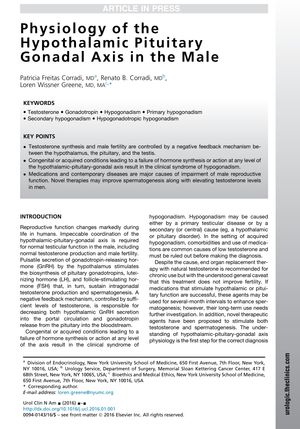TLDR The document explains how the male reproductive system works, its role in making testosterone, and how conditions like obesity can disrupt it, leading to low testosterone and fertility issues.
The document from May 1, 2016, provides an overview of the hypothalamic-pituitary-gonadal (HPG) axis in males, its role in testosterone production and male fertility, and the conditions that can disrupt this system leading to hypogonadism. It explains the importance of pulsatile gonadotropin-releasing hormone (GnRH) secretion for reproductive function and the changes that occur during sexual development, such as the increase in luteinizing hormone (LH) pulses that trigger puberty. The document also discusses the impact of obesity and type 2 diabetes on hypogonadism, the diagnosis of androgen deficiency, and the treatment options for hypogonadism, including testosterone replacement therapy and alternative treatments like human chorionic gonadotropin (hCG) and GnRH for stimulating testosterone and spermatogenesis. It emphasizes the need for understanding the HPG axis to correctly diagnose and treat hypogonadism, which can significantly affect men's quality of life and lead to other health issues like osteoporosis.
 93 citations
,
February 2009 in “Annals of the New York Academy of Sciences”
93 citations
,
February 2009 in “Annals of the New York Academy of Sciences” 5α‐reductase isozymes are crucial for prostate development and health, and targeting them can help prevent and treat prostate issues.
 506 citations
,
March 2005 in “The Journal of Clinical Endocrinology and Metabolism”
506 citations
,
March 2005 in “The Journal of Clinical Endocrinology and Metabolism” Testosterone therapy improves physical function, strength, and body composition in older men with low testosterone levels.
 January 2018 in “Elsevier eBooks”
January 2018 in “Elsevier eBooks” The document explains how male reproductive hormones work and affect the body.
 35 citations
,
May 2022 in “Baillière's best practice and research in clinical endocrinology and metabolism/Baillière's best practice & research. Clinical endocrinology & metabolism”
35 citations
,
May 2022 in “Baillière's best practice and research in clinical endocrinology and metabolism/Baillière's best practice & research. Clinical endocrinology & metabolism” Androgens like testosterone are important hormones for both men and women, made differently in each sex and affecting the body by regulating genes and quick interactions with cell components.
 23 citations
,
October 2015 in “Andrology”
23 citations
,
October 2015 in “Andrology” New male hormonal contraceptives show promise but need more research on long-term effects and funding for larger trials.
 25 citations
,
March 2000 in “Journal of Endocrinological Investigation”
25 citations
,
March 2000 in “Journal of Endocrinological Investigation” Testosterone therapy aims to treat hormone deficiencies and various conditions safely and effectively, but requires careful patient monitoring due to potential side effects.
 19 citations
,
December 2021 in “Endocrine Reviews”
19 citations
,
December 2021 in “Endocrine Reviews” There are various effective hormone treatments for puberty induction in boys and girls with hypogonadism, and starting treatment early is important.







